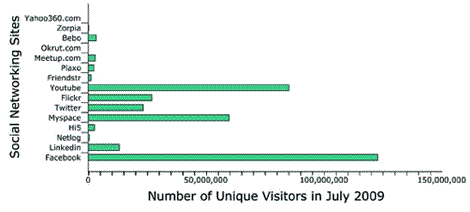- POPULAR ARTICLES
- Thank You Words
- Retirement Wishes
- Face to Face
What are Internet Social Networks?
Internet social networks are websites that can help you connect and stay in touch with the people you know.
These websites contain pages for each individual member, and pages for areas that are accessible to all members.
Some websites are geared to connect with friends and family and some are geared to connect with business contacts.
What can you expect to find on a social networking site?
• Individual profiles (including yours)
• Photo albums that members post
• A way for you to find people
• Applications, including Games
• Advertising/Classifieds
• A common area accessible to all members
• Common interest groups for you and other people to join
How many people use internet social networks?
Here is a chart that shows the most popular social networks and their ranking, given by the amount of visitors they got in a month.
How do I chose what social networking site to join?
You can join them all, but you run the risk of not being able to keep up with them.
Before you join an internet social network, you may want to read about the dangers of social networking sites.
Once you've decided to join a site, the list below can help you chose which site to join.
1. Facebook
When you join Facebook, you first create a profile with basic information about yourself. Later, you start adding applications that may either tell people more about yourself or are just there for pure entertainment.You can use Facebook to find people that you have lost track of. You can use it to keep people posted on what you do, the places you visit, the pictures and videos you take. There are groups about a particular subject, or a place, or a famous person, or an activity.
You can chose to post this information for one person, for a group or for all to see.
A recent piece of news (August 2009) reported that that Bill Gates just quit using his Facebook account because he couldn't keep up with so many friends anymore. That might give you something to think about.
2. MySpace
This website exploded in the early 2000. It is very similar to Facebook, people use the site to stay in touch with friends and family. People can post information, photographs, video clips, links, etc. The site also provides applications, some useful, some entertaining. The number of monthly visitors to the site was just surpassed by Facebook in July 2009. See stats.3. Twitter
Twitter is a website where you can post very short messages (140 characters) to keep people up to date on what you're doing.Some people enter status updates (tweets) very often, others let their status become stale, updating them every few days or weeks.
Twitter is immensely popular, as shown by the statistics on visitors per month. Still, a study just conducted by Pear Analytics in August 2009 shows that 40% of the "tweets" were "pointless babble".
4. LinkedIn
This networking site is geared toward the business crowd. You can post your resume or your credentials, you connect with business contacts, you sign up with groups that share your business or career interests.More than before, LinkedIn is being used for job hunting and recruiting. What makes LinkedIn different than job search sites like Monster or Ladders is that whatever you post is visible to all so there is less exaggeration on resumes.
Another feature that gives LinkedIn an edge is that its capability to map people’s networks and show degrees of separation between people.
As an example, a couple of years ago, while working in a WiFi project, I was trying to get in touch with the CIO of a large entertainment company to determine how the wireless network was going to affect the company where he worked.
I called him, wrote him letters, sent him emails, to no avail. I turned to LinkedIn and found there were only two degrees of separation between him and me, meaning I had a business friend who knew the CIO in question.
I contacted my friend asking him to introduce me to the CIO. Within two days, I was in contact with the CIO, all via LinkedIn. Later, I met him and his staff and got the information I needed.
5. YouTube
This quasi-networking site is geared toward sharing video clips. People create an account with YouTube.com (1) to have access to all video clips and (2) to be able to post messages for any given clip. In this site you can find hot videos, long tail videos, private videos, odd videos, you name it, YouTube plays it.6. Flickr
This site is geared toward sharing pictures with others, be it your contacts or the world. The site provides tools to edit your pictures, and tie them to maps where the pictures were taken, similar to Google Maps and others.Bottom Line
Online social networking does not replace real life networking. Internet social networks can't replace the mixers, the coffee breaks, the luncheons, the meetings, and the social gatherings. People still need face time and they still need human contact to tighten the bond between them.Internet social networks can help you reconnect with people from previous jobs and school mates, or just people you have lost track of. Once you find them, use the networking sites to stay in touch with them until you set the time aside to see them in person. Nothing beats that.
Related articles about Technology and Human Communication




